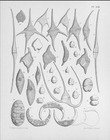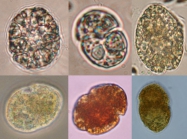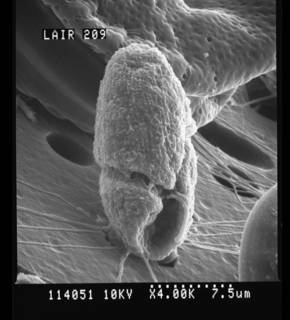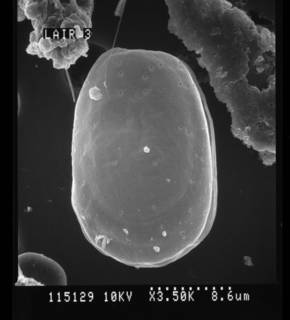WoRMS taxon details
Gymnodinium F.Stein, 1878
Proaulax Diesing, 1866 · unaccepted (synonym)
Rhizodinium Baumeister ex Bourrelly, 1955 · unaccepted (synonym)
- Species Gymnodinium abbreviatum Kofoid & Swezy, 1921
- Species Gymnodinium achromaticum Lebour, 1917
- Species Gymnodinium acutissimum Okolodkov, 1997
- Species Gymnodinium acutiusculum Okolodkov, 1997
- Species Gymnodinium adriaticum (Schmarda) Kofoid & Swezy, 1921
- Species Gymnodinium aequatoriale Hasle, 1960
- Species Gymnodinium agaricoides P.H.Campbell, 1973
- Species Gymnodinium agiliforme Schiller, 1928
- Species Gymnodinium albidum J.B.Lackey & E.W.Lackey, 1970
- Species Gymnodinium albulum Er.Lindemann, 1928
- Species Gymnodinium allophron J.Larsen, 1994
- Species Gymnodinium amphityphlum J.Larsen, 1994
- Species Gymnodinium amphora Kofoid & Swezy, 1921
- Species Gymnodinium amplinucleum P.H.Campbell, 1973
- Species Gymnodinium antarcticum A.E.Thessen, D.J.Patterson & S.A.Murray, 2012
- Species Gymnodinium arcticum Wulff, 1919
- Species Gymnodinium arcuatum Kofoid, 1931
- Species Gymnodinium arenicola Dragesco, 1965
- Species Gymnodinium atomatum J.Larsen, 1994
- Species Gymnodinium attenuatum Kofoid & Swezy, 1921
- Species Gymnodinium aurantium P.H.Campbell, 1973
- Species Gymnodinium auratum Kofoid & Swezy, 1921
- Species Gymnodinium aureolum (E.M.Hulburt) Gert Hansen, 2000
- Species Gymnodinium aureum Kofoid & Swezy, 1921
- Species Gymnodinium australense Ruiner, 1938
- Species Gymnodinium baccatum Balech, 1965
- Species Gymnodinium bicaudatum Pavillard, 1905
- Species Gymnodinium biconicum J.Schiller, 1928
- Species Gymnodinium bicorne Kofoid & Swezy, 1921
- Species Gymnodinium bifurcatum Kofoid & Swezy, 1921
- Species Gymnodinium bilobatum Van Meel, 1969
- Species Gymnodinium birotundatum van Goor, 1925
- Species Gymnodinium boguense P.H.Campbell, 1973
- Species Gymnodinium boguensis P.H.Campbell, 1973
- Species Gymnodinium bonaerense Akselman, 1985
- Species Gymnodinium boreale Gaarder, 1953
- Species Gymnodinium canus Kofoid & Swezy, 1921
- Species Gymnodinium capitatum Conrad & Kufferath, 1954
- Species Gymnodinium caput J.Schiller, 1928
- Species Gymnodinium cassieorum R.E.Norris, 1961
- Species Gymnodinium catenatum H.W.Graham, 1943
- Species Gymnodinium chiasmonetrium Norris, 1961
- Species Gymnodinium chukwanii D.Ballantine, 1961
- Species Gymnodinium cinctum Kofoid & Swezy, 1921
- Species Gymnodinium cnodax Conrad & Kufferath, 1954
- Species Gymnodinium contractum Kofoid & Swezy, 1921
- Species Gymnodinium corii J.Schiller, 1928
- Species Gymnodinium corollarium A.M.Sundström, Kremp & Daugbjerg, 2009
- Species Gymnodinium costatum Kofoid & Swezy, 1921
- Species Gymnodinium cruciatum J.Massart
- Species Gymnodinium cucumis Schütt, 1895
- Species Gymnodinium cyaneofungiforme Conrad & Kufferath, 1954
- Species Gymnodinium danicans P.H.Campbell, 1973
- Species Gymnodinium dentatum J.Larsen, 1994
- Species Gymnodinium diamphidium R.E.Norris, 1961
- Species Gymnodinium diploconus Schütt, 1895
- Species Gymnodinium dissimile Kofoid & Swezy, 1921
- Species Gymnodinium dogielii Kofoid & Swezy, 1921
- Species Gymnodinium doma Kofoid & Swezy, 1921
- Species Gymnodinium dorsalisulcum (Hulbert, J.J.A.McLaughlin & Zahl) Shauna Murray, Salas & Hallegraeff, 2007
- Species Gymnodinium elongatum B.Hope, 1954
- Species Gymnodinium endofasciculum P.H.Campbell, 1973
- Species Gymnodinium enorme Ballantine, 1964
- Species Gymnodinium exechegloutum R.E.Norris, 1961
- Species Gymnodinium filum Lebour, 1917
- Species Gymnodinium flavum Kofoid & Swezy, 1921
- Species Gymnodinium fossarum Conrad & Kufferath, 1954
- Species Gymnodinium fukushimae Hada, 1966
- Species Gymnodinium fulgens Kofoid & Swezy, 1921
- Species Gymnodinium fuscum (Ehrenberg) F.Stein, 1878
- Species Gymnodinium fusiforme Kofoid & Swezy, 1921
- Species Gymnodinium fusus Schütt, 1896
- Species Gymnodinium galaeformis Matzenauer, 1933
- Species Gymnodinium galeaeforme Matzenauer, 1933
- Species Gymnodinium galeatum J.Larsen, 1994
- Species Gymnodinium galeiforme Okolodkov, 1997
- Species Gymnodinium galesianum P.H.Campbell, 1973
- Species Gymnodinium gelbum Kofoid, 1931
- Species Gymnodinium gibbera J.Schiller, 1928
- Species Gymnodinium glandiforme Conrad & Kufferath, 1954
- Species Gymnodinium gleba Schütt, 1895
- Species Gymnodinium gracilentum P.H.Campbell, 1973
- Species Gymnodinium grammaticum (Pouchet) Kofoid & Swezy, 1921
- Species Gymnodinium guttiforme J.Larsen, 1994
- Species Gymnodinium guttula Balech, 1976
- Species Gymnodinium hamulus Kofoid & Swezy, 1921
- Species Gymnodinium herbaceum Kofoid, 1921
- Species Gymnodinium heterostriatum Kofoid & Swezy, 1921
- Species Gymnodinium hiroshimaense Hada, 1968
- Species Gymnodinium hulburtii P.H.Campbell, 1973
- Species Gymnodinium impudicum (S.Fraga & I.Bravo) Gert Hansen & Moestrup, 2000
- Species Gymnodinium incertum E.C.Herdman, 1924
- Species Gymnodinium incisum Kofoid & Swezy, 1921
- Species Gymnodinium incoloratum Conrad & Kufferath, 1954
- Species Gymnodinium inconstans van Meel, 1969
- Species Gymnodinium intercalare Bursa, 1961
- Species Gymnodinium inusitatum H.Gu, 2013
- Species Gymnodinium irregulare B.Hope, 1954
- Species Gymnodinium japonicum Hada, 1974
- Species Gymnodinium katodiniforme Elbrachter, 1979
- Species Gymnodinium kesslitzii (J.Schiller) Moestrup, 2018
- Species Gymnodinium kowalevskii Pitzik, 1967
- Species Gymnodinium lachmannii Kent, 1881
- Species Gymnodinium lanskoi Rouchijajnen, 1968
- Species Gymnodinium lazulum Hulburt, 1957
- Species Gymnodinium leptum R.E.Norris, 1961
- Species Gymnodinium lineatum Kofoid & Swezy, 1921
- Species Gymnodinium lineopunicum Kofoid & Swezy, 1921
- Species Gymnodinium litoralis A.Reñé, 2011
- Species Gymnodinium lobularis P.H.Campbell, 1973
- Species Gymnodinium loburare P.H.Campbell, 1973
- Species Gymnodinium lucidum D.Ballantine, 1964
- Species Gymnodinium luteo-viride van Meel, 1969
- Species Gymnodinium maguelonnense Biecheler, 1952
- Species Gymnodinium mammosum van Meel, 1969
- Species Gymnodinium marinum Kent, 1880
- Species Gymnodinium massarti J.Schiller, 1932
- Species Gymnodinium maximum Nordli, 1951
- Species Gymnodinium metum Hulburt, 1957
- Species Gymnodinium microreticulatum C.J.S.Bolch, Negri & G.M.Hallegraeff, 1999
- Species Gymnodinium minor Lebour, 1917
- Species Gymnodinium minus Lebour, 1917
- Species Gymnodinium minutulum J.Larsen, 1994
- Species Gymnodinium modestum Balech, 1976
- Species Gymnodinium multilineatum Kofoid & Swezy, 1921
- Species Gymnodinium multistriatum Kofoid & Swezy, 1921
- Species Gymnodinium najadeum J.Schiller, 1928
- Species Gymnodinium nanum Schiller, 1928
- Species Gymnodinium neapolitanum J.Schiller, 1928
- Species Gymnodinium nolleri M.Ellegaard & Ø.Moestrup, 1999
- Species Gymnodinium nucaceum Okolodkov, 1997
- Species Gymnodinium obliquum Okolodkov, 1997
- Species Gymnodinium oceanicum Hasle, 1960
- Species Gymnodinium ochraceum Kofoid, 1931
- Species Gymnodinium octo J.Larsen, 1994
- Species Gymnodinium oppressum Conrad, 1926
- Species Gymnodinium opressum Conrad, 1926
- Species Gymnodinium ostenfeldii J.Schiller, 1928
- Species Gymnodinium ovatocapitatum Van Meel, 1969
- Species Gymnodinium ovoideum Okolodkov, 1997
- Species Gymnodinium ovulum Kofoid & Swezy, 1921
- Species Gymnodinium pallidum Skuja, 1939
- Species Gymnodinium parvum J.Larsen, 1994
- Species Gymnodinium patagonicum Balech, 1971
- Species Gymnodinium paulseinii Schiller
- Species Gymnodinium paulsenii J.Schiller, 1928
- Species Gymnodinium perplexum van Meel, 1969
- Species Gymnodinium pingue van Meel, 1969
- Species Gymnodinium placidum E.C.Herdman, 1922
- Species Gymnodinium polycomma J.Larsen, 1994
- Species Gymnodinium prolatum J.Larsen, 1994
- Species Gymnodinium pulchrum J.Schiller, 1928
- Species Gymnodinium pumilum J.Larsen, 1994
- Species Gymnodinium punctatum Pouchet, 1887
- Species Gymnodinium puniceum Kofoid & Swezy, 1921
- Species Gymnodinium purpureum Skuja, 1956
- Species Gymnodinium pygmaeum Lebour, 1925
- Species Gymnodinium pyrenoidosum T.Horiguchi & Chihara, 1988
- Species Gymnodinium radiatum Kofoid & Swezy, 1921
- Species Gymnodinium ravenescens Kofoid & Swezy, 1921
- Species Gymnodinium regulare van Meel, 1969
- Species Gymnodinium rete Schutt, 1895
- Species Gymnodinium rhomboides Schütt, 1895
- Species Gymnodinium roseostigma P.H.Campbell, 1973
- Species Gymnodinium rubricauda Kofoid & Swezy, 1921
- Species Gymnodinium rubrocinctum Lebour, 1925
- Species Gymnodinium rubrum Koifoid & Swezy, 1921
- Species Gymnodinium scaphium van Meel, 1969
- Species Gymnodinium schaefferi S.Morris, 1937
- Species Gymnodinium scopulosum Kofoid & Swezy, 1921
- Species Gymnodinium semidivisum J.Schiller, 1928
- Species Gymnodinium servatum W.Busch, 1927
- Species Gymnodinium situla Kofoid & Swezy, 1921
- Species Gymnodinium smaydae N.S.Kang, H.J.Jeong & Ø. Moestrup., 2014
- Species Gymnodinium soyai Hada, 1970
- Species Gymnodinium sphaericum (Calkins) Kofoid & Swezy, 1921
- Species Gymnodinium sphaeroideum Kofoid, 1931
- Species Gymnodinium stellatum Hulburt, 1957
- Species Gymnodinium striassimum Hulbert
- Species Gymnodinium subroseum P.H.Campbell, 1973
- Species Gymnodinium subrufescens G.W.Martin, 1929
- Species Gymnodinium suffuscum van Meel, 1969
- Species Gymnodinium sulcatum Kofoid & Swezy, 1921
- Species Gymnodinium telma van Meel, 1969
- Species Gymnodinium translucens Kofoid & Swezy, 1921
- Species Gymnodinium translucens P.H.Campbell, 1973
- Species Gymnodinium trapeziforme Attaran-Fariman & Bolch, 2007
- Species Gymnodinium triangularis Lebour, 1917
- Species Gymnodinium uberrimum (G.J.Allman) Kofoid & Swezy, 1921
- Species Gymnodinium valdecompressum P.H.Campbell, 1973
- Species Gymnodinium variabile E.C.Herdman, 1924
- Species Gymnodinium vas Van Meel, 1969
- Species Gymnodinium venator Flo Jørgensen & Murray, 2004
- Species Gymnodinium verruculosum P.H.Campbell, 1973
- Species Gymnodinium violescens Kofoid & Swezy, 1921
- Species Gymnodinium virescens Wood, 1963
- Species Gymnodinium viridaliut J.Schiller, 1955
- Species Gymnodinium viridans van Meel, 1969
- Species Gymnodinium viridescens Kofoid, 1931
- Species Gymnodinium voukii J.Schiller, 1928
- Species Gymnodinium wilczekii Pouchet, 1894
- Species Gymnodinium wulffii J.Schiller, 1933
- Species Gymnodinium acutiusclum Okolodkov, 1997 accepted as Gymnodinium acutiusculum Okolodkov, 1997
- Species Gymnodinium affine Dogiel, 1906 accepted as Chytriodinium affine (Dogiel) Chatton, 1920
- Species Gymnodinium agile Kofoid & Swezy, 1921 accepted as Durinskia agilis (Kofoid & Swezy) Saburova, Chomérat & Hoppenrath, 2012 (synonym)
- Species Gymnodinium agile Herdman, 1922 accepted as Herdmania litoralis J.D.Dodge, 1981 (synonym)
- Species Gymnodinium archimedis Pouchet, 1883 accepted as Cochlodinium archimedes (Pouchet) Lemmermann, 1899 (synonym)
- Species Gymnodinium arenicolum Dragesco, 1965 accepted as Gymnodinium arenicola Dragesco, 1965
- Species Gymnodinium asymmetricum Massart, 1920 accepted as Katodinium asymmetricum (Massart) A.R.Loeblich, III, 1965 (synonym)
- Species Gymnodinium bei H.J.Spero, 1987 accepted as Pelagodinium bei (H.J.Spero) Siano, Montresor, Probert & Vargas, 2010 (deleted in Algaebase)
- Species Gymnodinium breve C.C.Davis, 1948 accepted as Karenia brevis (C.C.Davis) Gert Hansen & Moestrup, 2000 (basionym)
- Species Gymnodinium brevisulcatum F.H.Chang, 1999 accepted as Karenia brevisulcata (F.H.Chang) Gert Hansen & Moestrup, 2000 (basionym)
- Species Gymnodinium chlorophorum Elbrächter & Schnepf, 1996 accepted as Lepidodinium chlorophorum (M.Elbrächter & E.Schnepf) Gert Hansen, Botes & Salas, 2007 (synonym)
- Species Gymnodinium coeruleum Dogiel, 1906 accepted as Balechina coerulea (Dogiel) F.J.R.Taylor, 1976 accepted as Cucumeridinium coeruleum (Dogiel) F.Gomez, P.López-García, H.Takayama & D.Moreira, 2015 (synonym)
- Species Gymnodinium conicum Kofoid & Swezy, 1921 accepted as Spatulodinium pseudonoctiluca (Pouchet) J.Cachon & M.Cachon, 1968 (synonym)
- Species Gymnodinium fissum Levander, 1894 accepted as Levanderina fissa (Levander) Moestrup, Hakanen, Gert Hansen, Daugbjerg & M.Ellegaard, 2014 (basionym)
- Species Gymnodinium frigidum Balech, 1965 accepted as Gymnodinium antarcticum A.E.Thessen, D.J.Patterson & S.A.Murray, 2012
- Species Gymnodinium fungiforme Anisimova, 1926 accepted as Speroidium fungiforme (Anisimova) Moestrup & Calado, 2018
- Species Gymnodinium galatheanum Braarud, 1957 accepted as Karlodinium veneficum (D.Ballantine) J.Larsen, 2000 (synonym)
- Species Gymnodinium geminatum Schütt, 1895 accepted as Cochlodinium geminatum (Schütt) Schütt, 1896 accepted as Polykrikos geminatus (Schütt) D.Qiu & S.Lin, 2013 (synonym)
- Species Gymnodinium glandula E.C.Herdman, 1924 accepted as Aduncodinium glandula (E.C.Herdman) N.S.Kang, H.J.Jeong & Moestrup, 2015
- Species Gymnodinium glaucum Conrad, 1926 accepted as Amphidinium conradii J.Schiller, 1932 (synonym)
- Species Gymnodinium gracile Bergh, 1882 accepted as Balechina gracilis (Bergh) F.Gómez, Artigas & Gast, 2021
- Species Gymnodinium halophilum Biecheler, 1952 accepted as Biecheleria halophila (Biecheler) Moestrup, Lindberg & Daugbjerg, 2009
- Species Gymnodinium helix Pouchet, 1887 accepted as Cochlodinium helix Lemmermann, 1899 (synonym)
- Species Gymnodinium helix Schütt, 1895 accepted as Cochlodinium helix Lemmermann, 1899 (synonym)
- Species Gymnodinium hiemale Woloszynska, 1917 accepted as Jadwigia hiemalis (Woloszynska) Moestrup, 2018
- Species Gymnodinium instriatum (Freudenthal & J.J.Lee) D.W.Coats, 2002 accepted as Levanderina fissa (Levander) Moestrup, Hakanen, Gert Hansen, Daugbjerg & M.Ellegaard, 2014
- Species Gymnodinium lebourae Pavillard, 1921 accepted as Gymnodinium lebouriae Pavillard, 1921 accepted as Spatulodinium pseudonoctiluca (Pouchet) J.Cachon & M.Cachon, 1968 (misspelling)
- Species Gymnodinium lebouriae Pavillard, 1921 accepted as Spatulodinium pseudonoctiluca (Pouchet) J.Cachon & M.Cachon, 1968
- Species Gymnodinium leopoliensis Woloszynska, 1917 accepted as Woloszynskia leopoliensis (Woloszynska) R.H.Thompson, 1951 accepted as Tovellia leopoliensis (Woloszynska) Moestrup, K.Lindberg & Daugbjerg, 2005 (synonym)
- Species Gymnodinium linucheae R.V.Trench & L.-V.Thinh, 1995 accepted as Symbiodinium linucheae (Trench & Thinh) T.C.LaJenesse, 2001
- Species Gymnodinium lira Kofoid & Swezy, 1921 accepted as Cucumeridinium lira (Kofoid & Swezy) F.Gómez, P. López-García, H.Takayama & D.Moreira, 2015
- Species Gymnodinium lohmannii Paulsen, 1908 accepted as Gymnodinium gracile Bergh, 1882 accepted as Balechina gracilis (Bergh) F.Gómez, Artigas & Gast, 2021 (synonym)
- Species Gymnodinium lunula Schütt, 1895 accepted as Pyrocystis lunula (Schütt) Schütt, 1896 (synonym)
- Species Gymnodinium microadriaticum (Freudenthal) F.J.R.Taylor, 1971 accepted as Symbiodinium microadriaticum LaJeunesse, 2017 (synonym)
- Species Gymnodinium micrum (B.Leadbeater & J.D.Dodge) Loeblich III, 1970 accepted as Karlodinium veneficum (D.Ballantine) J.Larsen, 2000 (synonym)
- Species Gymnodinium mikimotoi Miyake & Kominami ex Oda, 1935 accepted as Karenia mikimotoi (Miyake & Kominami ex Oda) Gert Hansen & Moestrup, 2000 (synonym)
- Species Gymnodinium minutum Lebour, 1925 accepted as Heterocapsa rotundata (Lohmann) Gert Hansen, 1995 (synonym)
- Species Gymnodinium monadicum (Deising) W.S.Kent, 1881 accepted as Gymnodinium partitum (Perty) Moestrup, 2018
- Species Gymnodinium myriopyrenoides H.Yamaguchi, T.Nakayama, A.Kai & I.Inouye, 2011 accepted as Nusuttodinium myriopyrenoides (H.Yamaguchi, T.Nakayama, A.Kai & I.Inouye) Y.Takano & H.Yamaguichi, 2014
- Species Gymnodinium nagasakiense H.Takayama & M.Adachi, 1985 accepted as Karenia mikimotoi (Miyake & Kominami ex Oda) Gert Hansen & Moestrup, 2000 (synonym)
- Species Gymnodinium natalense T.Horiguchi & R.N.Pienaar, 1994 accepted as Ansanella natalensis (T.Horiguchi & R.N.Pienaar) Dawut, Sym & T.Horiguchi, 2018
- Species Gymnodinium nelsonii G.W.Martin, 1929 accepted as Akashiwo sanguinea (K.Hirasaka) Gert Hansen & Moestrup, 2000 (synonym)
- Species Gymnodinium ovato-capitatum van Meel, 1969 accepted as Gymnodinium ovatocapitatum Van Meel, 1969
- Species Gymnodinium pachydermatum Kofoid & Swezy, 1921 accepted as Balechina pachydermata (Kofoid & Swezy) A.R.Loeblich Jr. & A.R.Loeblich III, 1968 accepted as Balechina gracilis (Bergh) F.Gómez, Artigas & Gast, 2021
- Species Gymnodinium parasiticum Dogiel, 1906 accepted as Chytriodinium parasititum (Dogiel) Chatton, 1912
- Species Gymnodinium parvulum Schütt, 1895 accepted as Gyrodinium parvulum (Schütt) Kofoid & Swezy, 1921
- Species Gymnodinium pascheri (Suchlandt) Schiller, 1954 accepted as Borghiella pascheri (Suchlandt) Moestrup, 2018 (synonym)
- Species Gymnodinium pellucidum Wulff, 1916 accepted as Gyrodinium pellucidum (Wulff) J.Schiller, 1933 (synonym)
- Species Gymnodinium pellucidum (E.C.Herdman) Flø Jørgensen & Shauna Murray, 2004 accepted as Gymnodinium venator Flo Jørgensen & Murray, 2004 (synonym)
- Species Gymnodinium pigmentosum (Dodge) Loeblich, 1970 accepted as Aureodinium pigmentosum Dodge, 1967 (synonym)
- Species Gymnodinium pirum Schütt, 1895 accepted as Cochlodinium pirum (Schütt) Lemmermann, 1921 (synonym)
- Species Gymnodinium polyphemus Pouchet accepted as Warnowia polyphemus (Pouchet) J.Schiller, 1933 (synonym)
- Species Gymnodinium pouchetii Lemmermann, 1899 accepted as Oodinium pouchetii (Lemmermann) Chatton, 1912
- Species Gymnodinium pseudonoctiluca Pouchet, 1885 accepted as Spatulodinium pseudonoctiluca (Pouchet) J.Cachon & M.Cachon, 1968 (synonym)
- Species Gymnodinium pulchellum J.Larsen, 1994 accepted as Takayama pulchella (Larsen) de Salas, Bolch & Hallegraeff, 2003 (synonym)
- Species Gymnodinium pyrocystis Jørgensen, 1912 accepted as Spatulodinium pseudonoctiluca (Pouchet) J.Cachon & M.Cachon, 1968 (synonym)
- Species Gymnodinium quadrilobatum T.Horiguchi & R.N.Pienaar, 1994 accepted as Dinothrix quadrilobata (T.Horiguchi & R.N.Pienaar) R.Onuma & T.Horiguchi (unaccepted > superseded combination)
- Species Gymnodinium roseum Dogiel, 1906 accepted as Chytriodinium roseum (Dogiel) Chatton, 1912
- Species Gymnodinium sangineum Hirasaka, 1924 accepted as Gymnodinium sanguineum K.Hirasaka, 1922 accepted as Akashiwo sanguinea (K.Hirasaka) Gert Hansen & Moestrup, 2000
- Species Gymnodinium sanguineum K.Hirasaka, 1922 accepted as Akashiwo sanguinea (K.Hirasaka) Gert Hansen & Moestrup, 2000 (synonym)
- Species Gymnodinium simplex (Lohmann) Kofoid & Swezy, 1921 accepted as Protodinium simplex Lohmann, 1908
- Species Gymnodinium spirale Bergh, 1882 accepted as Gyrodinium spirale (Bergh) Kofoid & Swezy, 1921 (synonym)
- Species Gymnodinium splendens Lebour, 1925 accepted as Akashiwo sanguinea (K.Hirasaka) Gert Hansen & Moestrup, 2000 (basionym)
- Species Gymnodinium strangulatum F.Schütt, 1895 accepted as Cochlodinium strangulatum (F.Schütt) F.Schütt, 1896 (synonym)
- Species Gymnodinium striatissimum E.M.Hulburt, 1957 accepted as Gyrodinium striatissimum (E.M.Hulburt) Gert Hansen & Ø.Moestrup, 2000 (synonym)
- Species Gymnodinium sugashimanii J.Cachon, H.Saton, M.Cachon & S.Sato, 1989 accepted as Gyrodinium sugashimanii J.Cachon, H.Saton, M.Cachon & S.Sato, 1989 (synonym)
- Species Gymnodinium tenuissimum Lauterborn, 1894 accepted as Borghiella tenuissima (Lauterborn) Moestrup, Gert Hansen & Daugbjerg, 2008
- Species Gymnodinium tintinnicola Lohmann, 1908 accepted as Duboscquella tintinnicola (Lohmann) Chatton
- Species Gymnodinium uncatenatum (Hulburt) Hallegraeff, 2002 accepted as Levanderina fissa (Levander) Moestrup, Hakanen, Gert Hansen, Daugbjerg & M.Ellegaard, 2014 (synonym)
- Species Gymnodinium veneficum D.Ballantine, 1956 accepted as Karlodinium veneficum (D.Ballantine) J.Larsen, 2000 (synonym)
- Species Gymnodinium vestifici Schütt, 1895 accepted as Kapelodinium vestifici (Schütt) Boutrup, Moestrup & Daugbjerg, 2016
- Species Gymnodinium viride Lebour, 1917 accepted as Gymnodinium conicum Kofoid & Swezy, 1921 accepted as Spatulodinium pseudonoctiluca (Pouchet) J.Cachon & M.Cachon, 1968 (synonym)
- Species Gymnodinium viridis Lebour, 1917 accepted as Gymnodinium conicum Kofoid & Swezy, 1921 accepted as Spatulodinium pseudonoctiluca (Pouchet) J.Cachon & M.Cachon, 1968 (synonym)
- Species Gymnodinium vitiligo D.Ballantine, 1956 accepted as Karlodinium vitiligo (D.Ballantine) J.Larsen, 2000 (synonym)
- Species Gymnodinium excavatum Van Meel, 1969 (uncertain)
- Species Gymnodinium falcatum V.G.Madhav & B.Kondalarao, 2004 (uncertain > unassessed)
marine, brackish, fresh, terrestrial
Not documented
LSID urn:lsid:algaebase.org:taxname:6790
LSID urn:lsid:algaebase.org:taxname:6790 [details]
Guiry, M.D. & Guiry, G.M. (2025). AlgaeBase. World-wide electronic publication, National University of Ireland, Galway (taxonomic information republished from AlgaeBase with permission of M.D. Guiry). Gymnodinium F.Stein, 1878. Accessed through: World Register of Marine Species at: https://www.marinespecies.org/aphia.php?p=taxdetails&id=109475 on 2025-06-30
Date
action
by
2004-12-21 15:54:05Z
created
db_admin
2006-07-12 06:39:56Z
changed
Camba Reu, Cibran
![]() The webpage text is licensed under a Creative Commons
Attribution 4.0 License
The webpage text is licensed under a Creative Commons
Attribution 4.0 License
Nomenclature
basis of record
Gómez, F. (2005). A list of free-living dinoflagellate species in the world's oceans. <em>Acta Bot. Croat.</em> 64(1): 129-212. [details] 
Other
additional source
Kofoid, C.A.; Swezy, O. (1921). The free-living unarmored Dinoflagellata. <em>Memoirs of the University of California.</em> 5: i-viii, 1-562., available online at https://www.biodiversitylibrary.org/page/20306447 [details] 
additional source Steidinger, K.A.; Tangen, K. (1997). Dinoflagellates. pp. 387-584. In: C.R. Tomas (ed.) (1997). Identifying Marine Phytoplankton. Academic Press: San Diego, CA [etc.] (USA). ISBN 0-12-693018-X. XV, 858 pp., available online at http://www.sciencedirect.com/science/article/pii/B9780126930184500057 [details]
additional source Guiry, M.D. & Guiry, G.M. (2025). AlgaeBase. <em>World-wide electronic publication, National University of Ireland, Galway.</em> searched on YYYY-MM-DD., available online at http://www.algaebase.org [details]
additional source Integrated Taxonomic Information System (ITIS). , available online at http://www.itis.gov [details]
additional source Hayward, P. J.; Nelson-Smith, A.; Shields, C. (1996). Collins pocket guide: sea shore of Britain and Europe. <em>Collins pocket guides. Harper-Collins Publishers: London, UK. ISBN 0-00-219955-6.</em> 352 pp. (look up in IMIS) [details]
additional source Parker, S.P. (Ed.) (1982). Synopsis and classification of living organisms. McGraw Hill Book Company: New York, NY (USA). ISBN 0-07-079031-0. 1166, 1232 pp. (look up in IMIS) [details]
additional source Steidinger, K.A.; Tangen, K. (1997). Dinoflagellates. pp. 387-584. In: C.R. Tomas (ed.) (1997). Identifying Marine Phytoplankton. Academic Press: San Diego, CA [etc.] (USA). ISBN 0-12-693018-X. XV, 858 pp., available online at http://www.sciencedirect.com/science/article/pii/B9780126930184500057 [details]
additional source Guiry, M.D. & Guiry, G.M. (2025). AlgaeBase. <em>World-wide electronic publication, National University of Ireland, Galway.</em> searched on YYYY-MM-DD., available online at http://www.algaebase.org [details]
additional source Integrated Taxonomic Information System (ITIS). , available online at http://www.itis.gov [details]
additional source Hayward, P. J.; Nelson-Smith, A.; Shields, C. (1996). Collins pocket guide: sea shore of Britain and Europe. <em>Collins pocket guides. Harper-Collins Publishers: London, UK. ISBN 0-00-219955-6.</em> 352 pp. (look up in IMIS) [details]
additional source Parker, S.P. (Ed.) (1982). Synopsis and classification of living organisms. McGraw Hill Book Company: New York, NY (USA). ISBN 0-07-079031-0. 1166, 1232 pp. (look up in IMIS) [details]
 Present
Present  Inaccurate
Inaccurate  Introduced: alien
Introduced: alien  Containing type locality
Containing type locality
From editor or global species database
LSID urn:lsid:algaebase.org:taxname:6790 [details]Unreviewed
Classification This genus was originally placed under the family Gymnodiniidae as proposed by Hayward and Ryland (1990). [details]Diet general for group: both heterotrophic (eat other organisms) and autotrophic (photosynthetic) [details]
Ecology Blooms of this genus were recorded as early as 1937 in the Oslo Fjord (Braarud, 1945) an have occured more recently as G. sanguinum with concentrations up to 35 106 ind/l. [details]
Habitat pelagic [details]
Importance General: known for producing dangerous toxins, particularly when in large numbers, called "red tides" because the cells are so abundant they make water change color. Also they can produce non-fatal or fatal amounts of toxins in predators (particularly shellfish) that may be eaten by humans. [details]
Predators marine microorganisms and animal larvae [details]
Reproduction general for group: both sexual and asexual [details]
| Language | Name | |
|---|---|---|
| Japanese | ギムノディニウム属 | [details] |
PlanktonNet Image
Published in AlgaeBase
Published in AlgaeBase (from synonym Rhizodinium Baumeister ex Bourrelly, 1955)
(from synonym Rhizodinium Baumeister ex Bourrelly, 1955)
Published in AlgaeBase (from synonym Proaulax Diesing, 1866)
(from synonym Proaulax Diesing, 1866)
To Biological Information System for Marine Life (BISMaL)
To European Nucleotide Archive, ENA (Gymnodinium)
To Genbank
To NMNH Extant Collection (114051.jpg)
To NMNH Extant Collection (115029.jpg)
To ITIS
Published in AlgaeBase

Published in AlgaeBase
 (from synonym Rhizodinium Baumeister ex Bourrelly, 1955)
(from synonym Rhizodinium Baumeister ex Bourrelly, 1955)Published in AlgaeBase
 (from synonym Proaulax Diesing, 1866)
(from synonym Proaulax Diesing, 1866)To Biological Information System for Marine Life (BISMaL)
To European Nucleotide Archive, ENA (Gymnodinium)
To Genbank
To NMNH Extant Collection (114051.jpg)
To NMNH Extant Collection (115029.jpg)
To ITIS





